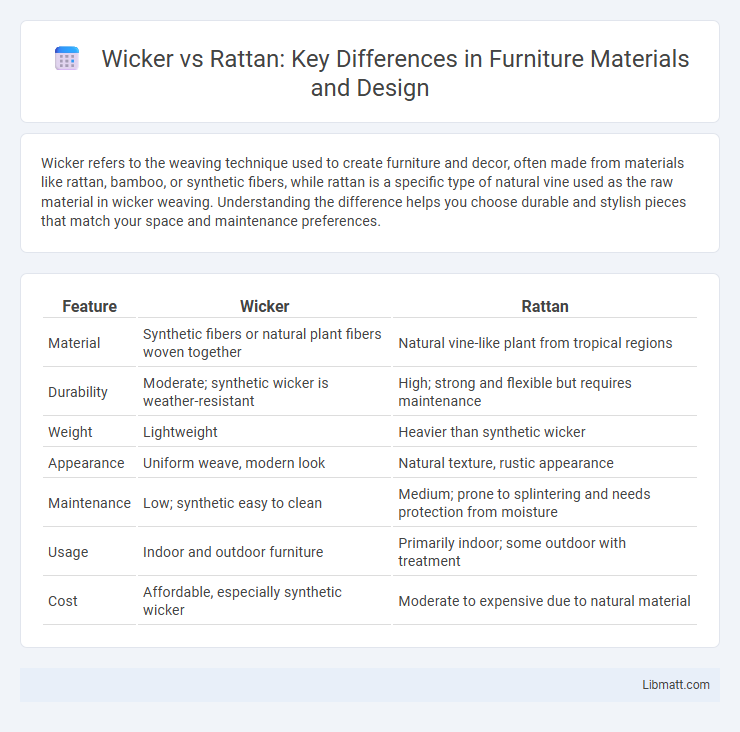Wicker refers to the weaving technique used to create furniture and decor, often made from materials like rattan, bamboo, or synthetic fibers, while rattan is a specific type of natural vine used as the raw material in wicker weaving. Understanding the difference helps you choose durable and stylish pieces that match your space and maintenance preferences.
Table of Comparison
| Feature | Wicker | Rattan |
|---|---|---|
| Material | Synthetic fibers or natural plant fibers woven together | Natural vine-like plant from tropical regions |
| Durability | Moderate; synthetic wicker is weather-resistant | High; strong and flexible but requires maintenance |
| Weight | Lightweight | Heavier than synthetic wicker |
| Appearance | Uniform weave, modern look | Natural texture, rustic appearance |
| Maintenance | Low; synthetic easy to clean | Medium; prone to splintering and needs protection from moisture |
| Usage | Indoor and outdoor furniture | Primarily indoor; some outdoor with treatment |
| Cost | Affordable, especially synthetic wicker | Moderate to expensive due to natural material |
Introduction: Wicker vs Rattan
Wicker and rattan are often used interchangeably but refer to different materials and techniques in furniture making. Wicker describes a weaving process using various natural or synthetic fibers, while rattan is a specific type of vine native to Southeast Asia utilized in wickerwork for its strength and flexibility. Understanding the distinction between wicker and rattan helps you make informed choices for durable, stylish furniture options.
Understanding Wicker: Definition and Origins
Wicker refers to a weaving technique used to create furniture and baskets, traditionally involving pliable plant materials like willow, reed, or bamboo. Originating over 4,000 years ago, wickerwork was first documented in ancient Egypt, showcasing its long-standing cultural significance. Unlike rattan, which is a specific vine used as a raw material, wicker emphasizes the crafting process rather than the source material.
What is Rattan? Material Overview
Rattan is a natural climbing palm plant native to tropical regions, prized for its strong, flexible stems used in furniture making and weaving. Unlike synthetic wicker, rattan is a sustainable material known for its durability and lightweight properties, making it ideal for both indoor and outdoor furniture. Its natural texture and ability to be easily shaped contribute to its popularity in crafting intricate and long-lasting home decor pieces.
Key Differences Between Wicker and Rattan
Wicker refers to the weaving technique used to create furniture and decor, while rattan is a specific type of natural vine used as the primary material in this craft. Wicker can be made from various materials like synthetic fibers, bamboo, or willow, whereas rattan is known for its lightweight, durable, and flexible qualities, making it ideal for outdoor furniture. Understanding the key differences between wicker and rattan helps you choose the best option for your style and durability needs.
Durability and Strength Comparison
Rattan is a natural vine known for its exceptional durability and flexibility, making it highly resistant to wear and tear, while wicker refers to the weaving technique that can be applied to various materials including rattan, bamboo, or synthetic fibers. Rattan furniture typically offers greater strength compared to synthetic wicker, with the ability to withstand heavy use and outdoor conditions without cracking or breaking. Synthetic wicker, however, provides enhanced resistance to moisture and UV damage, making it a durable alternative for outdoor environments where weather resistance is a priority.
Indoor vs Outdoor Use: Suitability and Performance
Wicker and rattan furniture both offer distinct advantages for indoor and outdoor use, with rattan excelling in durability due to its natural strength and resistance to weather elements, making it ideal for patios and garden spaces. Wicker, often made from synthetic materials, provides a versatile aesthetic well-suited for indoor environments where it avoids prolonged exposure to moisture and sunlight that can cause wear. Your choice depends on how the material handles moisture, UV exposure, and temperature changes to ensure long-lasting comfort and style in your living areas.
Maintenance and Care Tips
Wicker maintenance requires protecting the woven material from moisture and direct sunlight to prevent cracking and fading, with regular dusting and occasional gentle cleaning using a soft brush and mild soap solution. Rattan care involves keeping it dry to avoid mold and mildew, wiping it down with a damp cloth, and applying a light coat of furniture oil or lacquer to preserve its natural strength and flexibility. Your outdoor furniture's longevity depends on consistent care tailored to these materials' unique needs to maintain their appearance and durability.
Style, Design, and Aesthetic Appeal
Wicker offers a traditional, handwoven texture that complements rustic and vintage styles, creating a cozy and inviting aesthetic. Rattan showcases a sleek, natural look with smooth, sturdy poles ideal for contemporary and tropical designs, adding elegance and warmth to indoor and outdoor spaces. Both materials provide versatile design options but differ in texture and visual impact, with wicker focusing on intricate craftsmanship and rattan emphasizing natural simplicity.
Cost and Value Considerations
Wicker furniture, typically made from synthetic materials like resin, often comes at a more affordable price point than natural rattan, making it a cost-effective option for budget-conscious buyers. Rattan, harvested from tropical vines, generally commands a higher price due to its durability, natural aesthetic, and handmade craftsmanship, offering greater long-term value. Investing in rattan furniture may result in higher upfront costs but provides enhanced longevity and timeless appeal compared to the lower-cost, lightweight wicker alternatives.
Which is Better? Final Verdict
Rattan offers superior durability and flexibility, making it ideal for both indoor and outdoor furniture, while wicker refers to the weaving technique used on various materials, including rattan, bamboo, or synthetic fibers. Your choice depends on whether you prioritize natural strength and longevity or aesthetic versatility in design. For long-term investment and weather resistance, rattan furniture is generally better.
Wicker vs Rattan Infographic

 libmatt.com
libmatt.com